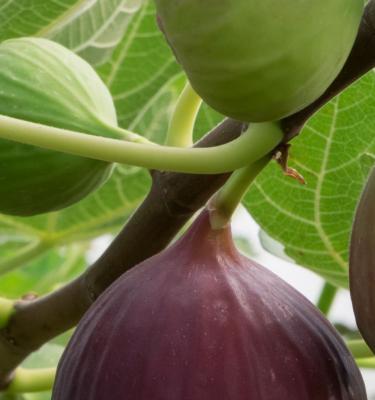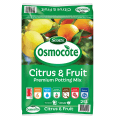

How to Grow Fig Trees
Fig trees originate from the Mediterranean where the summers are hot and dry, and winters cool - so they happily grow in many climates around Australia.
Figs are medium to large trees once fully grown, but they can be kept pruned to a manageable height or grown in large pots. Choose a full sun spot that's protected from strong winds. As fig trees hate waterlogged soils, make sure you select a free draining site or grow in a large container or raised bed if needed.
5 top tips for growing figs
- Choose a full sun position, sheltered from strong winds.
- Fig trees a free draining soil that’s been enriched with Scotts Osmocote® Compost Premium Soil Improver before planting.
- Fig trees are deciduous and will lose their leaves in winter - this is the ideal time to prune them.
- Fig trees will often fruit on both new and old growth, so you might be lucky and get 2 crops in a 12-month period.
- Fig trees can easily be propagated from cuttings taken in autumn
Essential shopping list for growing fig trees
- A potted fig tree
- Scotts Osmocote® Compost Premium Soil Improver
- Scotts Osmocote® Controlled Release Fertiliser: Tomato, Vegetable & Herb
- If growing in pots, Scotts Osmocote® Citrus & Fruit Potting Mix & Scotts Osmocote® Controlled Release Fertiliser: Citrus & Fruit
- Garden shovel
- Mulch
- Secateurs
- Wildlife safe crop protection netting
Prepare
Fig trees prefer a full sun spot that's protected from high winds. Choose a space with a free draining, neutral pH soil - they hate wet roots and can rot if planted into soil that gets waterlogged.
Prepare the soil for planting your fig tree by digging a hole that’s twice as wide as the root ball of your tree and the same depth.
Loosen the soil at the bottom of the hole and mix Scotts Osmocote® Compost Premium Soil Improver and Scotts Osmocote® Controlled Release Fertiliser: Citrus & Fruit through the original soil.
How to plant fig trees in the garden
Growing from potted fig trees
Potted fig trees can be purchased year round, but they are best planted in winter when the trees are dormant and less likely to suffer from transplant shock.
Plant your fig tree at the same depth it was in the pot. If needed, create a mound in your prepared planting hole to sit the root ball on so it’s at the correct height.
Add a stake to support fig trees at planting - this can be removed once the roots have taken.
Firm down the soil around the roots of your newly planted fig tree and water in well. Top dress around the tree with an open organic Mulch (but avoid touching the trunk) to suppress weeds and retain moisture.
Growing fig trees in containers
Choose dwarf or compact fig tree varieties to grow in pots. Find a pot or container with good drainage that’s at least 50-60cm wide and the same deep. An old half-wine barrel with drainage holes added is an ideal size. Fill your pot with a premium potting mix like Scotts Osmocote Citrus & Fruit Potting Mix before planting your fig tree into the centre of it.
Firm down the soil around your new tree and water it in well to settle its roots in.
Mulch the top of the soil in the pot to retain moisture and ensure the pot can be easily watered during the summer months.

When to pick figs in Australia
Figs are ready to pick once they droop slightly on the branch, smell sweet and are slightly soft. Figs won’t ripen off the tree, so they’re best picked fresh as you need them.
Some fig varieties crop twice in a 12 month period - the first crop on last years wood (called the breba crop) and then a second heavier crop in late summer on the new growth.
You may need to securely net your trees to protect the crop from hungry birds and other animals. Once the fruits have formed, use a wildlife safe, 4mm hole or smaller white netting that’s pulled tightly over the tree and secured around the truck or set up a frame structure over the tree so you can easily place the net over this.
Common fig tree pests & diseases & general fig tree care advice
If Queensland Fruit Fly are a pest in your area you may need to net with insect exclusion netting once the fruit have started to form.
Lightly prune fig trees in winter to keep their shape - aim to remove any broken, crossing or diseased branches and then lightly prune the whole tree to keep it compact. Remove any suckers that appear from the base of the tree - don’t throw the cuttings out, you can pot them up and grow more fig trees!
Fertilise in spring and again in autumn with Scotts Osmocote® Compost Premium Soil Improver or Scotts Osmocote® Controlled Release Fertiliser: Citrus & Fruit if you’re growing in pots.



